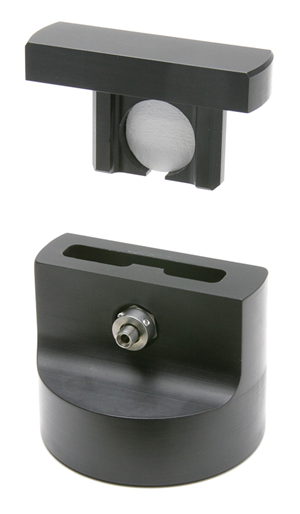

89575
QFT1 Filter Holder for Glass Fiber Filters- Overview
- Specifications
- Accessories
- Citations
- Related Products
Overview

There are 1 images available to view - click to enlarge and scroll through the product gallery.
QFT1 Instruction Manual
/ Download as PDF
QFT1 Data Sheet
/ Download as PDF
- Simple measurements for particulate absorption
- Rugged and portable
- Performs as well as a laboratory based spectrophotometer
Details
Simple measurements for particulate absorption
WPI’s filter holder for particulate absorption measurements is specially designed for field use. It is rugged and portable. It performs as well as a laboratory based spectrophotometer. It can be directly connected to WPI’s line of fiber optic spectrometers and light sources. Instead of collecting your samples, transporting them to a laboratory, and accepting the loss of spectral information associated with it (Sosik, 1999), particulate absorption can now be measured on site.
How does it work ?
Particulate absorption of fresh and seawater can be determined by filtering a known amount of sample through a Glass Fiber Filter (GF/F) and measuring the particulate absorption coefficient ap(λ) concentrated on the filter. This technique is called quantitative filter technique (QFT) and corrects for the pathlength amplification, an effect of scattering. The correction of the pathlength amplification and the correction of the non-linear relationship between the optical density of samples on a Whatman GF/F filter and in suspension are discussed in Mitchell (1990).
Detector and light source requirements
The optical throughput of QFT1 equipped with a classical GF/F filter is very low and requires a matched light source / spectrometer system. WPI’s TIDAS I in combination with WPI’s FO-6000 tungsten light source or D4H deuterium/halogen light source can be used in the 380–730?nm and 280–730 nm wavelength range, respectively. The QFT1 can be interfaced to any other CCD, PDA or scanning type spectrometer with fiber optic capabilities.
Performance
To test the performance of the QFT1, seawater samples were collected locally and filtered through a GF/F filter pad. The particulate absorption was measured with the QFT1 and for comparison with a Lambda 35 UV/VIS spectrometer equipped with a RSA-PE-20 integrating sphere attachment. The measured particulate absorbance spectra overlay well for a number of samples.
Advantage
A significant advantage of the filter holder is its large beam diameter of 5?mm, resulting in “averaging out” of larger non-organic particles frequently found on the filter pad when using natural samples. The removable filter fixture allows simple filter alternation and cleaning.
Specifications
| Fiber input and output | 200-1000um, SMA terminated, 600um fiber recommended |
| Glass Fiber Filter (GF/F) diameter | 25mm |
| Light beam diameter | 5mm |
| Light performance with GF/F* | >50% intensity at 3000ms integration time |
| Material in contact with Filter Pad | Delrin |
| Weight | 1.5kg (1 lb.) |
Accessories
Citations
Mitchell, B. G., “Algorithms for Determining the Absorption Coeffi cient of Aquatic Particles Using the Quantitative Filter Technique (QFT)”, SPIE Vol. 1302 Ocean Optics X (1990), 137-148.
Sosik, H. M., “Storage of marine particulate samples for light-absorption measurements”, Limnol. Oceanogr., 44(4), 1999, 1139-1141
Belz, M., Larsen, K., Klein, F. “Fiber optic sample cells for polychromatic detection of dissolved and particulate matter in natural waters”, Proc. SPIE, Vol. 6377, Oct 2006, 63770X




Request
Catalogue
Chat
Print